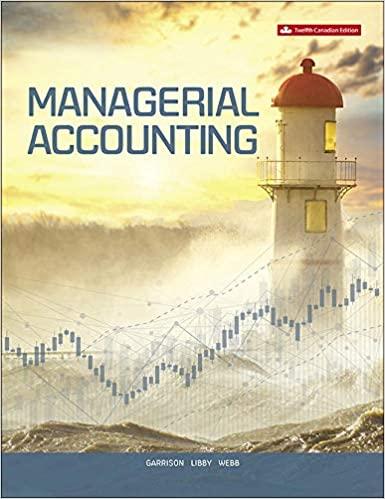Stephen Scott recently joined the Finance and Planning Division of the Bank of Ontario as an assistant
Question:
Stephen Scott recently joined the Finance and Planning Division of the Bank of Ontario as an assistant chief financial officer (CFO). The Bank is a publicly owned company. Scott is a Chartered Professional Accountant and has spent the previous four years working in the accounting department of a large Canadian manufacturing company. He took the job at the bank because it provided an opportunity to get some international business experience. One of Scott's responsibilities is to perform an initial review of the capital budgeting proposals developed by the various divisions at the bank. Because the bank's divisions are very large and have a high degree of operating autonomy, each division has its own divisional controller, who prepares the proposals with input from key managers in the division and other bank personnel. For 2021, the bank budgeted $500,000 for capital spending in each of the six major divisions for projects requiring less than $100,000 of expenditures. For projects of that size, the divisions are free to go ahead and spend the funds as they see fit, without the need for centralized review and approval. The bank budgeted a further $20 million in capital spending for 2021 to be allocated to the divisions on the basis of the project proposals submitted as part of the capital budget review process. These proposals are for individual projects requiring capital expenditures in excess of$100,000. All project submissions are ranked from most to least profitable using the project profitability index: Present value of the net cash inflows.;. Investment required. The bank uses a required return of 15% in determining the present value of net cash inflows from projects. The final review of the proposals is conducted by the CFO, the assistant CFO, and the vice-president of Finance (VPF). In addition to these three individuals, the review meeting is attended by the senior manager and controller of each division. Non-financial factors, such as the importance of the expenditure for maintaining the bank's competitive position and its impact on customer retention and growth, are considered as part of the review and approval process. However, these factors typically have a smaller impact on the final decision than the project profitability index, which senior management believes to be more objective and reliable.
As part of his initial review of the proposals, Scott was instructed by the CFO to evaluate the reasonableness of the assumptions and to check the accuracy of the calculations. Where necessary, he was to follow up with the divisional controllers if he had any questions about the details. As Scott began his review, he was struck by the relatively high project profitability index on the vast majority of the projects. In several instances, the assumptions underlying the proposal seemed very optimistic, so he decided to follow up with the individual divisional controllers. Almost without fail, the controllers admitted to using highly optimistic cash inflows in order to make their proposals look as good as possible. The controllers also commented that the division managers viewed the capital budget review process as a game that they wanted to win by getting as many of their projects approved as possible. As one controller put it, "What's the harm in a little optimism as long as the estimates in all of the proposals are more or less equally overstated?" Scott also learned from the controllers that word had leaked out that last year only those projects with a project profitability index over 30% were funded, and that they had been instructed by their divisional managers to make sure that all current-year proposals met that threshold. Some of the divisional controllers also suggested that it was clear that senior management at the bank condoned the optimism included in their proposals since the use of post-audits had been discontinued several years ago after the CFO at the time (who has since been replaced) concluded that the cost of the audits exceeded their benefits.
As Scott sat in his office after a conversation with one of the divisional controllers, he wasn't sure what to do next. The divisional controllers told him he'd be wasting his time going to the CFO or the VPF, since they all knew how the capital budgeting game was being played. He was also concerned that rocking the boat would upset the divisional controllers, with whom he had to work closely on other aspects of his job. But he couldn't shake the feeling that this was an issue that deserved more attention.
Required:
Review pages 1-4 of the Chartered Professional Accountants of Ontario CPA Code of Professional Conduct at https://media.cpaontario.ca/stewardship-of-the-profession/pdfs/CPA-Ontario-Code-ofprofessional-conduct.pdf
1. Which principles of the Ontario CPA Code of Professional Conduct might Scott be in violation of if he takes no action?
2. What should Scott do?
3. What would be some benefits of post-audits for capital projects in excess of $100,000 at the Bank of Ontario?
4. Will post-audits eliminate the problem of inaccurate estimates and assumptions being experienced at the Bank of Ontario? Why or why not?
Step by Step Answer:

Managerial Accounting
ISBN: 9781260193275
12th Canadian Edition
Authors: Ray H. Garrison, Alan Webb, Theresa Libby





